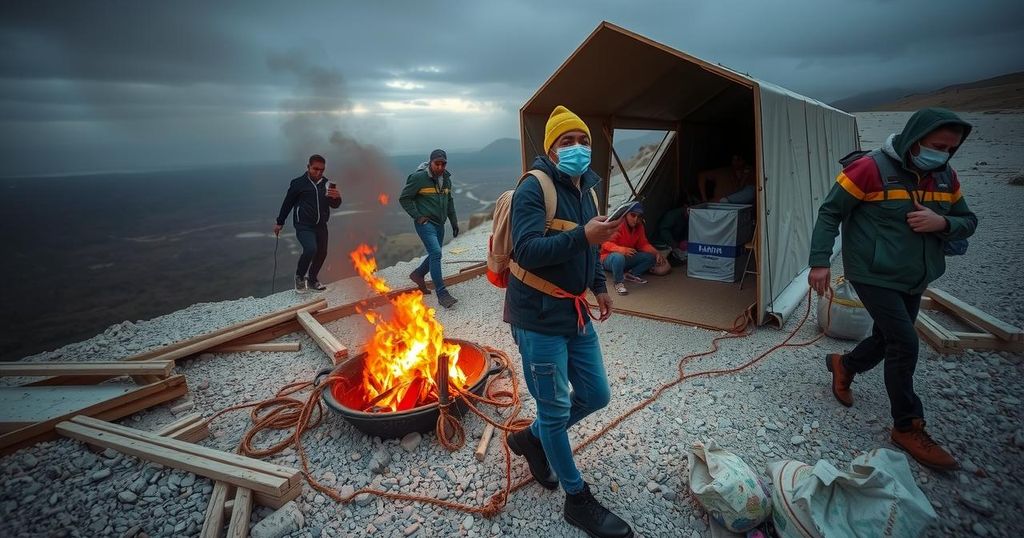Ethiopia is evacuating 80,000 residents due to recent earthquakes raising fears of volcanic eruptions. The government responds to significant seismic activity in Afar, Oromia, and Amhara regions, fostering safety and assessing infrastructure vulnerabilities. Experts highlight the urgency for updated building codes to ensure public safety amidst increasing geological risks.
Ethiopia is currently undertaking an extensive evacuation effort for approximately 80,000 residents in response to a series of earthquakes impacting the Afar, Oromia, and Amhara regions. Over the past week, the country experienced at least ten earthquakes, with the latest documented tremor registering at a magnitude of 5.8, occurring near the Awash Fentale district in the early hours of Saturday. Authorities have indicated that these seismic events may be precursors to potential volcanic activity in the region.
The United States Geological Survey reported significant activity approximately 56 kilometers southeast of Ambosa in Oromia. Local experts confirm that the epicenter of the seismic activity is situated on Dofen Mountain, an area of concern due to rising indications of volcanic risk. A second tremor soon followed, measured at 4.7, intensifying local fears of possible eruptions as vent activity in the Dofen volcano has become apparent.
Ethiopian officials are responding proactively by deploying emergency workers and exercise assessments within multiple districts. More than 51,000 individuals in the Afar and Oromia regions have been identified as at risk due to the earthquakes, prompting urgent evacuation measures for vulnerable populations. Specific risks were noted in the Fentale district, where over 16,000 residents are under threat. Reports indicate that local residents are evacuating homes after experiencing powerful shockwaves that disrupted their daily lives.
While no casualties have yet been reported, there has been considerable damage to homes, particularly in Afar, where changing geological formations are creating new challenges. Local residents recounted their experiences of sudden tremors while asleep, describing unique circumstances that compelled them to seek safety outdoors.
The government has urged citizens to adhere to precautionary measures outlined by experts and continues to monitor structural vulnerabilities across its cities, particularly in Addis Ababa. Experts assert that many structures in the capital are inadequately equipped to endure significant seismic events, with calls for updating existing building codes that have not evolved since their introduction in 1983. The Ethiopian Construction Authority has acknowledged the growing concern and is mobilizing efforts to reinforce public infrastructures against strong earthquakes.
As the situation develops, authorities remain vigilant in their assessments while reassuring the public of their commitment to safety and infrastructure integrity. Those affected are being directed to report any concerning developments, thus tightening a safety net around vulnerable communities in a region marked by dynamic geological activity.
In recent weeks, Ethiopia has faced a notable increase in seismic activity, culminating in a series of earthquakes that have raised concerns among residents and governmental officials alike. The regions primarily affected include Afar, Oromia, and Amhara, with tremors escalating in size and frequency, prompting an evacuation of tens of thousands of people. There is rising apprehension regarding potential volcanic eruptions due to observable activity at the Dofen volcano. Experts within the country are emphasizing the structural vulnerabilities of Ethiopian buildings, urging updates to infrastructure codes that protect against such natural disasters.
The urgent evacuation of approximately 80,000 residents in Ethiopia highlights the seriousness of the current seismic activity experienced across various regions. With fears of volcanic eruptions and ongoing assessments of the structural integrity of buildings, the Ethiopian government is actively responding to ensure public safety. As experts continue to monitor the situation and provide guidance, there remains a critical need for infrastructural reform to safeguard communities against future geological threats.
Original Source: www.voanews.com






